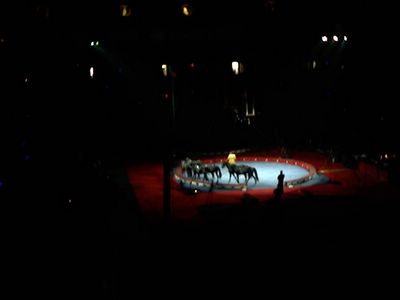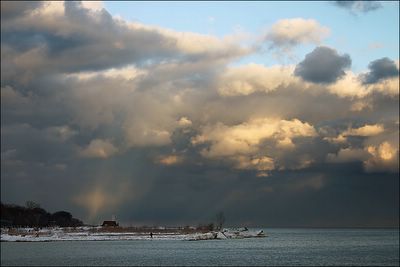Monday, December 11, 2006
How To Start A Trading Day
Monday December 11, 3:43 pm ET
By Brett Steenbarger
Trading is not so different. A few minutes performing checks before you start trading can make the difference between starting out the day in the hole or in the green.
There are many questions I ask myself at the start of a market day: Is today likely to be a trending day or a range bound day? Are we likely to see volatile price action or slow meandering? Are we likely to test recent highs or lows? All of these are important questions for short-term traders. Because most stocks show a significant, positive correlation with the movement of the stock indices, handicapping the odds of the index moving in a particular way can provide a useful edge.
Here are a few items that consistently form a part of my "pre-flight checklist" during the opening minutes of market trade in the equity indices:
1) Trading volume in the first few five-minute segments of the session - Volume correlates very highly with volatility, and volume tells us if large, institutional participants are in the market. Low volume compared with recent norms tells us that we have a market dominated primarily by locals and we can expect lower volatility and range bound trade. The volatile, trending moves tend to occur when we sustain above average volume. If I see volume increasing on directional moves, I am much more likely to go with strength or weakness. If volume tails off as moves progress, I'm more likely to fade the move.
2) The distribution of the NYSE TICK ($TICK) and the Dow TICK ($TIKI) - Recall that the TICK measures are constant updates on the number of stocks trading at their offer price minus those trading at their bids. These provide us with the shortest-term sentiment information possible. I think of the TICK as a moment-to-moment poll of sentiment among the traders who are active in the markets at that time. As with volume, I am looking at how the TICK measures are distributed relative to recent norms. If we see both TICK measures skewed in a positive direction relative to recent sessions, the odds of sustained upward movement are greatly increased. Similarly, a sustained negative skew to the TICK measures tends to occur during downward trending days. It's where we see little skew and/or a mixed skew between the two measures that we tend to get range bound action.
3) The behavior of global markets - I keep my eye not only on European stocks, but also on gold, oil, bonds, and the dollar. If these markets are moving significantly and breaking out to new levels, we're more likely to see a repricing of equities. Quiet global macro markets provide little incentive for large traders to reprice equities, and that's when we see range bound drifting markets. I especially keep in the back of my mind "themes" that have dominated the global markets, such as weak dollar/strong bonds (economic strength/weakness themes) and the relationships among gold, oil, and stocks (inflation themes). I generally want to trade in the direction of those themes.
4) Recent trading ranges and support/resistance - Think in Market Profile terms. We want to identify the market's value range, and we want to identify how the market trades as we test the upper and lower boundaries of that range. The first range that is important to me is the pre-opening Globex range. I also want to look at the range from 7:30 AM CT to the open if we've had an economic report prior to the open. Ditto the 7:30 AM - 9:00 AM CT range if we get numbers early in the trading session. We also want to be aware of the previous day's range and how the market trades as we test prior days' highs and lows. If we cannot generate increased volume and participation as the market tests range extremes, we're much more likely to fall back into that range. The good directional moves occur when we break out of those ranges on enhanced volume.
5) Distribution of volume, especially of trades by large traders - This is the data I gather from the Market Delta program. I'm looking at the proportion of volume in my instrument (usually the ES futures) that is occurring at the bid price vs. the offer. I also place volume filters on the data so that I only observe the distribution of large trades at the bid vs. offer. This tells me if large locals and large institutions are primarily buyers or sellers. I always want to be trading in the direction of the whales. Indeed, I generally will not place my first trade of the day until I have a good sense for how the large traders are participating in the market.
You may very well start your market day with a different pre-flight check list based on your time frame and market. That's fine. The important thing is to turn your list into a regular morning routine. The captains of sea crafts never leave port without their maps and weather gauges--and a plan for their voyages. Those make the difference between smooth sailing and a rough voyage.
Wednesday, July 19, 2006
Athens Muslims to get a mosque
| By Andrew Burroughs BBC News, Athens |
Over recent years immigration has brought hundreds of thousands of Muslims to the Greek capital.
But while freedom of worship is guaranteed by Greece's constitution as a member of the European Union, proposals for a new mosque have proved controversial in a country whose population is 96% Greek Orthodox.
There are mosques dating from Ottoman times in the old part of Athens known as Plaka. The Fethiye or victory mosque dates back to 1458. But today these buildings are for tourists not for Muslim prayers. One is now a museum of Greek folk art.
Athens is the only EU capital without a purpose-built place of worship for its Muslim population.
| | We don't want another Kosovo here close to Athens Dr Athanasius Papagiorgiou |
The city's 200,000 or so Muslims have been meeting in disused basements and whatever space the community can find.
Technically these buildings lack proper legal permission to function as places of worship, though the city authorities, aware of the problem, have allowed meetings to continue while a solution is sought.
Demonstrations
In the run-up to the Olympics, and under pressure to portray Greece as internationalist and conciliatory, the then socialist government chose a site for a Saudi-sponsored mosque and Islamic centre east of Athens to be visible from the international airport.
That provoked demonstrations by nearby residents of the staunchly conservative town of Peannia.
Today there's a small Greek Orthodox chapel on site, built to commemorate the protests which thwarted the mosque proposal. On special occasions a bell is rung, and on the hilltop a cross now defiantly looks towards the airport.
"We are Orthodox Christians here," says Angelo Kouias, a Peannia resident, involved in the protests. "We believe that when you arrive at the frontier of Greece it would be better to see a church to symbolise our country rather than a mosque."
"We don't want another Kosovo here close to Athens," says Dr Athanasius Papagiorgiou, a surgeon and president of the group which opposed the plan, the religiously conservative Association of St John. "Kosovo used to be a centre for the orthodox faith, and today it's nothing."
Lost privilege
Professor George Moustakis represents a different face of orthodoxy - a campaigner for interfaith understanding who joined a petition in favour of a mosque 17 years ago.
"I've always opposed the connection of church and state here in Greece, which has meant the church took the decision about other denominations and other faiths and their buildings for worship," he says.
| | The Muslims of Athens are Greek tax-payers and we have a right to pray in a respectful building Naim El Ghandour |
"Parliament has now voted and the church lost that privilege. So there is no problem about the mosque, the government supports it, so does the Orthodox Church."
With the church veto gone and support from the current centre-right government, Naim El Ghandour - who in daily life imports high fashion fabric designs - is the man coordinating plans for a new mosque to be built in the north of Athens.
"The Muslims of Athens are Greek tax-payers and we have a right to pray in a respectful building," he says "We're asking the government for financial help. We're not looking for foreign sponsors, this will be a Greek mosque for Greek Muslims."
The saga of the Athens mosque finds echoes elsewhere in Europe. Spain has just witnessed the opening of its first new mosque since the 16th Century when the Spanish re-conquered the Iberian peninsular from the Moorish Islamic rulers who built the historic mosques and palaces of Andalusia.
The new mosque in Granada opened for worship only after two decades of objections from the local authorities on planning grounds.
And in Italy a mosque planned for seven years in Colle di Val d'Elsa in a picturesque corner of Tuscany has divided the local community. There the local authority supports the need for a mosque but there have been objections from residents.
It is a scenario likely to be repeated around the EU as the need for immigrant labour draws into the community those of a different faith, who then naturally wish to take up their equal right to a place of worship.
Tuesday, July 18, 2006
this article is for my economics buddies !!
US 'could be going bankrupt'
By Edmund Conway, Economics Editor
(Filed: 14/07/2006)
telegraph.co.uk
The United States is heading for bankruptcy, according to an extraordinary paper published by one of the key members of the country's central bank.
A ballooning budget deficit and a pensions and welfare timebomb could send the economic superpower into insolvency, according to research by Professor Laurence Kotlikoff for the Federal Reserve Bank of St Louis, a leading constituent of the US Federal Reserve.
Prof Kotlikoff said that, by some measures, the US is already bankrupt. "To paraphrase the Oxford English Dictionary, is the United States at the end of its resources, exhausted, stripped bare, destitute, bereft, wanting in property, or wrecked in consequence of failure to pay its creditors," he asked.
According to his central analysis, "the US government is, indeed, bankrupt, insofar as it will be unable to pay its creditors, who, in this context, are current and future generations to whom it has explicitly or implicitly promised future net payments of various kinds''.
The budget deficit in the US is not massive. The Bush administration this week cut its forecasts for the fiscal shortfall this year by almost a third, saying it will come in at 2.3pc of gross domestic product. This is smaller than most European countries - including the UK - which have deficits north of 3pc of GDP.
Prof Kotlikoff, who teaches at Boston University, says: "The proper way to consider a country's solvency is to examine the lifetime fiscal burdens facing current and future generations. If these burdens exceed the resources of those generations, get close to doing so, or simply get so high as to preclude their full collection, the country's policy will be unsustainable and can constitute or lead to national bankruptcy.
"Does the United States fit this bill? No one knows for sure, but there are strong reasons to believe the United States may be going broke."
Experts have calculated that the country's long-term "fiscal gap" between all future government spending and all future receipts will widen immensely as the Baby Boomer generation retires, and as the amount the state will have to spend on healthcare and pensions soars. The total fiscal gap could be an almost incomprehensible $65.9 trillion, according to a study by Professors Gokhale and Smetters.
The figure is massive because President George W Bush has made major tax cuts in recent years, and because the bill for Medicare, which provides health insurance for the elderly, and Medicaid, which does likewise for the poor, will increase greatly due to demographics.
Prof Kotlikoff said: "This figure is more than five times US GDP and almost twice the size of national wealth. One way to wrap one's head around $65.9trillion is to ask what fiscal adjustments are needed to eliminate this red hole. The answers are terrifying. One solution is an immediate and permanent doubling of personal and corporate income taxes. Another is an immediate and permanent two-thirds cut in Social Security and Medicare benefits. A third alternative, were it feasible, would be to immediately and permanently cut all federal discretionary spending by 143pc."
The scenario has serious implications for the dollar. If investors lose confidence in the US's future, and suspect the country may at some point allow inflation to erode away its debts, they may reduce their holdings of US Treasury bonds.
Prof Kotlikoff said: "The United States has experienced high rates of inflation in the past and appears to be running the same type of fiscal policies that engendered hyperinflations in 20 countries over the past century."
Paul Ashworth, of Capital Economics, was more sanguine about the coming retirement of the Baby Boomer generation. "For a start, the expected deterioration in the Federal budget owes more to rising per capita spending on health care than to changing demographics," he said.
"This can be contained if the political will is there. Similarly, the expected increase in social security spending can be controlled by reducing the growth rate of benefits. Expecting a fix now is probably asking too much of short-sighted politicians who have no incentives to do so. But a fix, or at least a succession of patches, will come when the problem becomes more pressing."
City offers some 'stay cool' advice
Another scorcher prompts heat alert
Jul. 16, 2006. 01:38 PM
LINDA NGUYEN
STAFF REPORTER
Environment Canada is expecting temperatures in the city to hit a record high of 36 degrees celsius today. The sweltering conditions have prompted Toronto Public Health to issue the fourth extreme heat alert of the summer and warn people to stay inside.
Extreme heat alerts are issued by Toronto Public Health based on a "heat health model” that measures the likelihood of someone dying from the heat rather than whether temperatures scorch to an all-time high.
“We want folks to enjoy the summer but also take extra precautions. Taking those extra precautions will also prevent you from getting sick or seriously hurt. Don’t go out in the direct sun and if you do make sure you wear lots of sunscreen and a wide-brim hat or have an umbrella, which is a fashionable way to shield the sun from hitting you,” said Marco Vittiglio, manager of emergency planning and preparedness.
He recommends using your common sense to stay cool.
“We want the public not to overexert themselves. Wear light clothing and light coloured clothing. Keep windows open and take showers or bathers in cool water. Have a fan close by to circulate the air,” he said.
And if you were thinking of sitting on a patio under a scorching sun and enjoying a pitcher of beer, Vittiglio is urging you to think twice today. “Avoid drinking alcohol and caffeinated beverages. Avoid eating hot meals or spicy meals instead, eat light meals. Don't eat a heavy meal with lots of protein like steak, potatoes and all the workings. Stay on the lighter side today with maybe a salad,” he said.
He points out that people should also think about doing a “neighbours helping neighbours thing” where they look out for members in their community like isolated seniors or people who are immobile.
Elaine Smyer reminds the public that even if they don’t have air conditioning or fans in their homes, they can go to a number of public places in the city - including four civic centres - to cool off.
Several hundred people use these cooling centres, which are only open when an extreme heat alert is called, to grab some water, juice or cereal bars.
“Some people hear about it and pack their lunch and spend the day. It’s really a place for some liquid and to hydrate. There’s also medical personnel if you need some medical attention,” said Smyer, who is the city's manager of emergency planning, shelter, support and housing administration.
Public libraries and community centres are also an ideal place to stay away from the scorching sun, she said.
Many pools across the city have extended their hours for those wanting to take a dip. You can call their hotline at 416-338-POOL for more information or for a location near you.
Metro Hall civic centre will stay open for 24 hours while the other three cooling centres are open from 11 a.m. to 7 p.m. today.
City Cooling Centres Locations
- Metro Hall, 55 John Street (John and King)
- East York Civic Centre, 850 Coxwell Avenue (Coxwell and Mortimer)
- Etobicoke Civic Centre, 399 The West Mall (Burnhamthorpe and Hwy 427)
- North York Civic Centre, 5100 Yonge Street (Yonge and Sheppard)


























